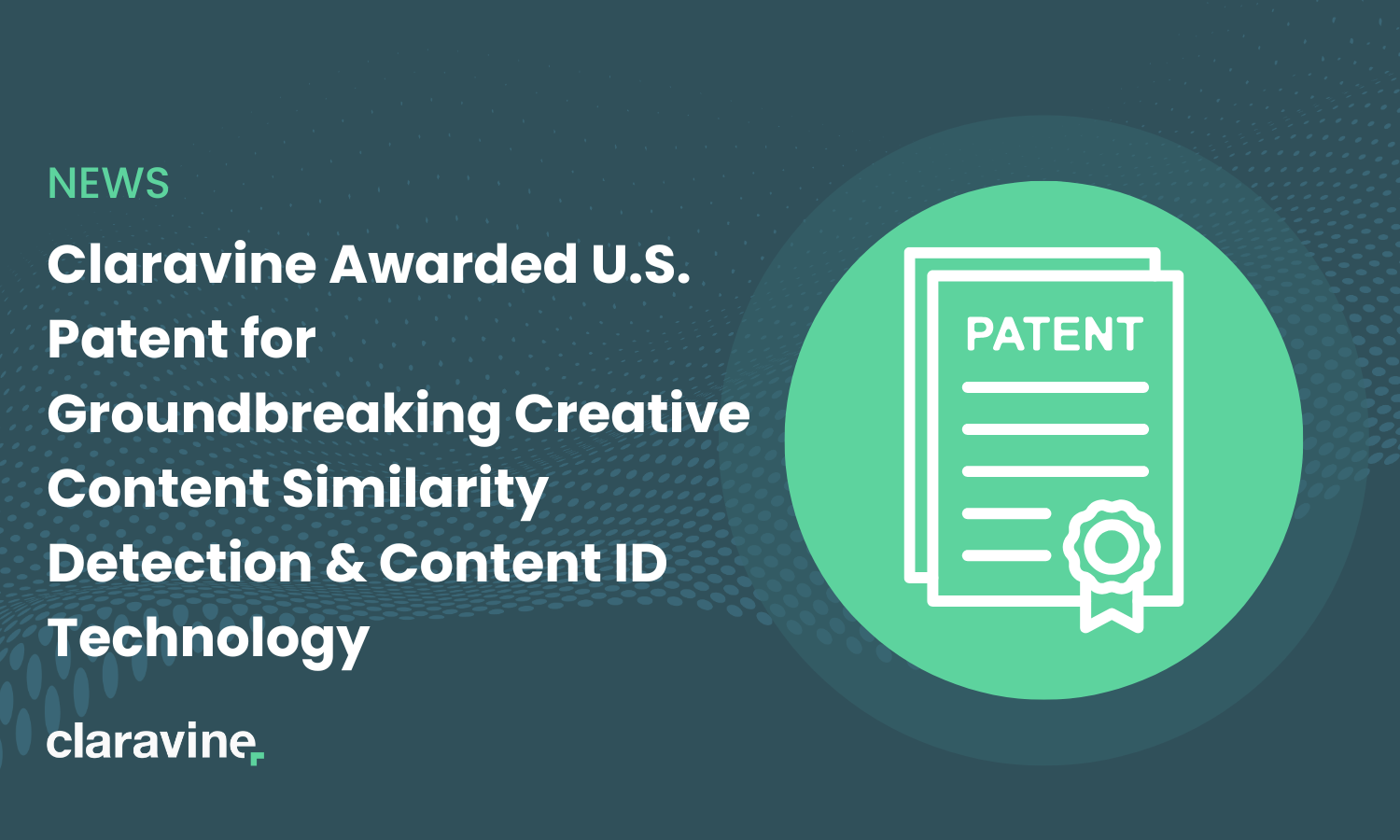Taking the Drama Out of Creative Chaos: Claravine’s Patent for Content Similarity & Content ID
 In the modern marketing landscape, content is king—but keeping it organized is often a royal headache. From image variants for social platforms to repetitive video edits, creative teams generate endless versions of assets. Left unmanaged, this proliferation leads to inconsistent metadata, duplicated spend, inability to measure creative performance, and confusion across systems. That’s why today’s news is such a milestone: That’s why today’s news is such a milestone: Claravine has officially been awarded a U.S. patent for Content Similarity and Content ID technology—a foundational innovation powering our Data Standards Cloud® platform.
In the modern marketing landscape, content is king—but keeping it organized is often a royal headache. From image variants for social platforms to repetitive video edits, creative teams generate endless versions of assets. Left unmanaged, this proliferation leads to inconsistent metadata, duplicated spend, inability to measure creative performance, and confusion across systems. That’s why today’s news is such a milestone: That’s why today’s news is such a milestone: Claravine has officially been awarded a U.S. patent for Content Similarity and Content ID technology—a foundational innovation powering our Data Standards Cloud® platform.
And while patents don’t always make headlines in marketing tech, this one is important. It’s not just a defensive move. It’s a signal to our customers that the technology they rely on is customizable and built to last. Claravine’s approach to data standards and metadata management is genuinely novel and not just a twist on existing methods. Here is what this means in the larger sense:
1. Creativity and Customization at Scale Needs Structure
Imagine a global campaign: dozens of ad formats, localization versions, recycled hero imagery, A/B test variants—suddenly you’re managing hundreds of creative assets. And each asset might carry a slightly different filename, format, or placement context.
Without structure, chaos creeps in: assets go unused, metadata drifts, and teams duplicate effort. That’s where Content ID steps in.
Claravine’s patented system uses a smart combination of perceptual intelligence (like visual likeness) and non-perceptual cues (like additional metadata or content type) to group, track, and tag assets—even when they’ve been edited, cropped, or reformatted.
So, when a hero image changes, all relevant variants stay connected—GIFs, translated versions, thumbnails. It’s metadata with memory.
2. What Makes This Patent Unique
Patents don’t just protect ideas—they validate them. In granting this patent, the USPTO recognized that Claravine’s approach is novel, non-obvious, and technically inventive. That matters. Customers can rest easy knowing they are investing in cutting-edge, differentiated solutions designed to grow with them and deliver success over the long term.
Instead of relying on standard fingerprinting or basic hashing, we built a dynamic, layered system that is:
- Modular – Works across DAMs, CMSs, ad platforms, and custom tools
- Adaptive – Learns similarity patterns across text, visuals, and metadata
- Contextual – Understands creative intent, not just file properties
It’s not just metadata — it’s a self-aware metadata engine that evolves with your creative and your brand.
3. Why This Patent Adds Value for Our Customers
Let’s talk about what this means for you—our enterprise customers, partners, and platform users.
Confidence in Your Stack
- A patent proves the underlying technology is proprietary and original. You’re not buying into a trend or a thinly-veiled repackaging—you’re investing in genuinely innovative tech that’s designed to scale with your business.
Reduced Risk
- In highly regulated enterprise industries like pharma, healthcare, and finance, platform decisions must be defensible. A patent strengthens Claravine’s credibility, giving your compliance teams—and your executive stakeholders—confidence that the solution won’t be challenged or compromised. This provides stability and reduces the risk of their chosen solution becoming obsolete.
Stability & Longevity
- This isn’t vaporware. This is a platform feature that’s here to stay. With IP protection in place, you can rely on Claravine to support evolving use cases without legal ambiguity or vendor lock-in concerns.
Fuel for Future Innovation
- A patent isn’t the end of innovation—it’s the beginning. Protecting this core technology allows us to reinvest in enhancements, integrations, and new applications that benefit you.
“This isn’t just about IP,” says Bernard Ngombi Kiyanda, Claravine’s Chief Technology & Product Officer. “It’s about giving our customers confidence that the tools they use today will still be leading the industry tomorrow.”
4. How It Works – The Smart Tech Behind the Patent
Here’s what the Content ID system does under the hood:
1. A user submits a media asset via integration or API.
2. The system ingests and evaluates the asset using:
- Perceptual data (e.g., layout, imagery, design elements via ML models)
- Non-perceptual data (e.g., customer info, content category, size)
3. It generates a unique Content ID, checking for matches or similarities.
4. Results are surfaced within your platform for action, creating content relationships, and optimize automation from planning to activation.
It’s like giving your content a fingerprint and a family tree—at the same time. Say your U.S. team launches a campaign asset, and your EMEA team wants to localize it. Claravine recognizes the lineage, connects the metadata, and automatically maps relationships—so reuse becomes smarter, and reporting becomes simpler.
5. The Claravine Difference: Why Patents Matter in Martech and Adtech
Our mission has always been to take the drama out of data—and that includes creative content. By earning this patent, we’re showing that Claravine doesn’t just follow trends. We create them. We build for the long haul. And we protect what we build, because our customers deserve technology that’s as reliable as it is forward-thinking. “This patent is for every team trying to bring order to creative chaos,” says Kiyanda. “We built this for you—and we’re proud to share it.”
To the customers who trusted us early, to the engineers who brought this vision to life, and to the marketers who know the pain of messy metadata — thank you. This milestone is yours too.
As we like to say: We saw the power of AI before it went mainstream — and we built data standards that let it thrive. We standardize not just data, but content and context consistency. This patent assures customers, partners, and investors that Claravine doesn’t just talk innovation; we create it.
Do you want to see what smart content similarity can do for your workflows? Let’s connect. We’ll show you how to eliminate guesswork, amplify reuse, and standardize content with confidence.



